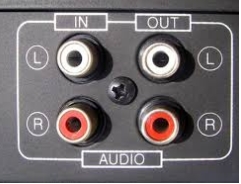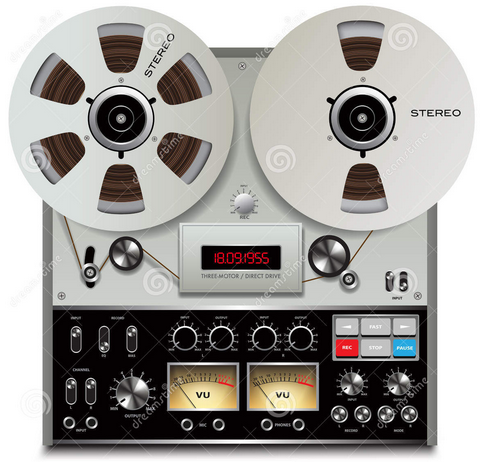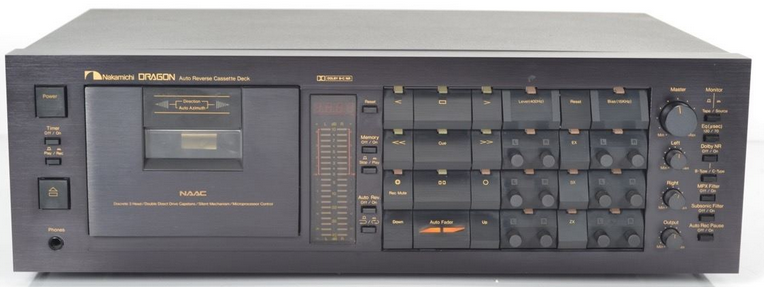Ed's
AV Handbook
Batting Practice for the AV Professional
and primer for the novice
Chapter 5 Page 2
The AV System Sequence
Alternate route
The Record Loop
multi-room/multi-source
- Legacy receivers, some AV receivers, plus audiophile
preamps include a useful diverting exit and reentry
path.
It is the tape-monitor output and input record loop.
Think of the input/output loop as an audio off-ramp with a quick on-ramp. As a selected source begins its path to the pre-amp output, prior to entering any audio manipulation or processing, the source simultaneously exits at the record output.

The source volume at the record output is fixed. The fixed output can advance to the input of a recording device. The re-entry record input is still prior to any manipulating or processing. Engaging a front panel tape monitor switch allows the recorded audio to reenter and continue to the preamp output. Engaging the tape monitor over-rides all other source selection.
But why is the tape monitor a separate dedicated priority switch?
A point of tape loop confusion derives from the word monitor of the Tape Monitor switch. Monitor is to observe or listen.
Audio enthusiasts and the 3rd head
Many tape recorders provided a 3rd-head linked to a Tape Monitor switch on the recorder. The 3-head feature allows the listener to monitor, to listen, to the result of their recording as it is still recording.


The 3rd playback-only head is located after the 2nd record-only head, and the initial 1st erase/bias head. Engaging the recorder's Tape Monitor switch allows listening to the 3rd head playback result of the 2nd record head while recording. The tape deck includes a headphone monitor jack for this function.
The 3rd head result can also pass to a connected receiver/preamp via the tape deck output jacks to the receiver/preamp tape monitor input jacks. Therefore, selecting the receiver/preamp Tape Monitor switch also allows listening to the recorder 3rd head. This allows comparison between the selected source and the recording.
Silent and Confused
The tape loop confuses many owners of tape loop product.
The receiver/preamp tape monitor switch overrides all input selections.
If engaged, and a tape player is not connected while playing, listeners are confronted with silence.
Disengaging the tape monitor allows normally selected sources to pass.
Miss-engaged tape monitor switches led to many distressed phone calls to audio stores in the 1970s and 1980s.
- Note: If the loop was
not used, connecting the output to the input with an audio
interconnect avoided angry phone calls.
Record Loop Processing Options
1. The preamp record tape loop can optionally engage an equalizer, reverb, audio mixer, or surround sound decoder rather than a tape recorder.
The engaged tape monitor loop passes decoded, equalized, or reverb processed audio to the preamp output.
2. Many receivers and preamps also included a record-output selector. This switch offers the option of routing a source to the record output,
while allowing the main input selection switch to choose a different source to pass to the preamp output.
3. Many audio dealers used the tape output and record-output selector to route sources to an preamp/amplifier in another room or zone.
Multi-room / Multi-source
Many manufacturers have re-labeled the 'record output' as the 'multi-room output', and the 'record output selector' as a 'zone 2 source selector'. This feature promotes the routing of sources to an amplifier and speakers in another room or zone. However, they eliminated the Tape Monitor switch and its dedicated input.
Copyright 2007 Txu1-598-288 Revised 2024
Sponsored By

Architectural Speaker Tuning System
for
in-wall/ceiling custom installed speakers.
Reclaim
The Performance You Paid For
Site Menu
Home
Table of
Contents
Handbook Chapters
1 AV
Terms
2 AV Physics
3 Sound Reproduction
4 Video Reproduction
5 The AV System Sequence
6 The Room, Speaker, & TV
7 Acoustical Strategy - Small Room
8 Home Theater by Design
9 AV Sales Training
10 AV Business & Marketing
Contact
About